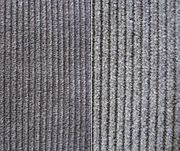
Corduroy
Encyclopedia


Textile
A textile or cloth is a flexible woven material consisting of a network of natural or artificial fibres often referred to as thread or yarn. Yarn is produced by spinning raw fibres of wool, flax, cotton, or other material to produce long strands...
composed of twisted fibers that, when woven, lie parallel (similar to twill
Twill
Twill is a type of textile weave with a pattern of diagonal parallel ribs . This is done by passing the weft thread over one or more warp threads and then under two or more warp threads and so on, with a "step" or offset between rows to create the characteristic diagonal pattern. Because of this...
) to one another to form the cloth's distinct pattern, a "cord." Modern corduroy is most commonly composed of tuft
Tufting
Tufting is a type of textile weaving in which a thread is inserted on a primary base.It is an ancient technique for making warm garments, especially mittens. After the knitting is done, short U-shaped loops of extra yarn are introduced through the fabric from the outside so that their ends point...
ed cords, sometimes exhibiting a channel (bare to the base fabric) between the tufts. Corduroy is, in essence, a ridged form of velvet
Velvet
Velvet is a type of woven tufted fabric in which the cut threads are evenly distributed,with a short dense pile, giving it a distinctive feel.The word 'velvety' is used as an adjective to mean -"smooth like velvet".-Composition:...
.
As a fabric
Textile
A textile or cloth is a flexible woven material consisting of a network of natural or artificial fibres often referred to as thread or yarn. Yarn is produced by spinning raw fibres of wool, flax, cotton, or other material to produce long strands...
, corduroy is considered a durable cloth. Corduroy is found in the construction of trousers
Trousers
Trousers are an item of clothing worn on the lower part of the body from the waist to the ankles, covering both legs separately...
, jackets and shirts. The width of the cord is commonly referred to as the size of the "wale" (i.e. the number of ridges per inch). The lower the "wale" number, the thicker the width of the wale (i.e., 4-wale is much thicker than 11-wale). Corduroy’s wale count per inch can vary from 1.5 to 21, although the traditional standard falls somewhere between 10 and 12. Wide wale is more commonly used in trousers; medium, narrow, and fine wale fabrics are usually found in garments worn above the waist.
Corduroy is made by weaving extra sets of fiber into the base fabric to form vertical ridges called wales. The wales are built so that clear lines can be seen when they are cut into pile. The primary types of corduroy are:
- Standard wale: 11 wales/inch, and available in many colors. This cloth is sturdy and practical.
- Pincord/pinwale/needlecord: Pincord is the finest cord around with a count at the upper end of the spectrum (above 16) and has a feel as soft as velveteen.
- Pigment dyed/printed corduroy: The process of coloring or printing corduroy with pigment dyes. The dye is applied to the surface of the fabric, then the garment is cut and sewn. When washed during the final phase of the manufacturing process, the pigment dye washes out in an irregular way, creating a vintage look. The color of each garment becomes softer with each washing, and there is a subtle color variation from one to the next. No two are alike.
Other names
Other names are often used for corduroy. Alternative names include: corded velveteen, elephant cord, pin cord, Manchester cloth and cords.In continental Europe, corduroy is commonly known simply as "Manchester" or "Cord".

